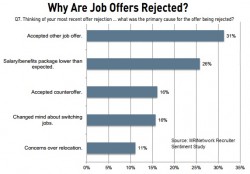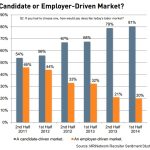 It’s a job seekers market, but hiring managers haven’t yet fully adjusted to the change, with 40 percent of them taking almost a month to make an offer, only to find out in many cases that their candidate is turning them down.
It’s a job seekers market, but hiring managers haven’t yet fully adjusted to the change, with 40 percent of them taking almost a month to make an offer, only to find out in many cases that their candidate is turning them down.
Better than 8 in 10 of the MRINetwork recruiters participating in the semi-annual MRINetwork Recruiter Sentiment Study said today’s employment market is candidate-driven, a 25-point jump from the 2012 study. That means the professional, executive, and managerial candidates who are the majority of those recruited by MRI franchise offices can be more demanding when it comes to the nature of the work they want, the companies they’re willing to work for, and the compensation and benefits they’ll accept.
In the MRI survey last fall, recruiters said 42 percent of their candidates who got an offer turned it down. In the current survey, recruiters reported that in almost a third (31 percent) of the turndowns, the reason is another offer. In yet another sign of the changing nature of the market, 26 percent said the candidates are rejecting offers because the comp and benefits aren’t what they expected. And current employers are fighting to hang on to top talent; 16 percent of the candidates accept counteroffers.
According to the survey, one recruiter, commenting on the hiring situation, said, “Candidates have more options than they have had in years. Yet clients still want to give low-ball offers.” Another noted, “Some clients are still not adjusting to this market change, and as a result are dragging the process along and losing good candidates.”
A few surveys back, recruiters were far more balanced in who they thought was driving the market. In the 2011 survey 54 percent of the respondents saw a candidate-driven labor market vs. 46 percent who saw it the other way.
Now, with the economy adding jobs at a pace unseen since before the recession, and an unemployment rate for the college-educated at 3.3 percent, there’s little doubt about the nature of the market. What’s more, the evidence is that the hiring environment is only going to continue to get more challenging for many types of professional and mid- to senior-level positions.
A recent CareerBuilder forecast predicted that nearly half of all companies would be adding headcount during the second half of this year. The Conference Board’s Employment Trends Index likewise points to strong hiring. Now, 47 percent of MRI’s recruiters in the survey say newly created positions are the primary reason for the job orders they have coming in.
Second to that are vacancies caused by resignations, prompting MRI to conclude, “Employment continues to accelerate and candidates are more willing to change jobs as a result of growing confidence in the job market. Employee fears regarding changing employers during the recession have subsided.”